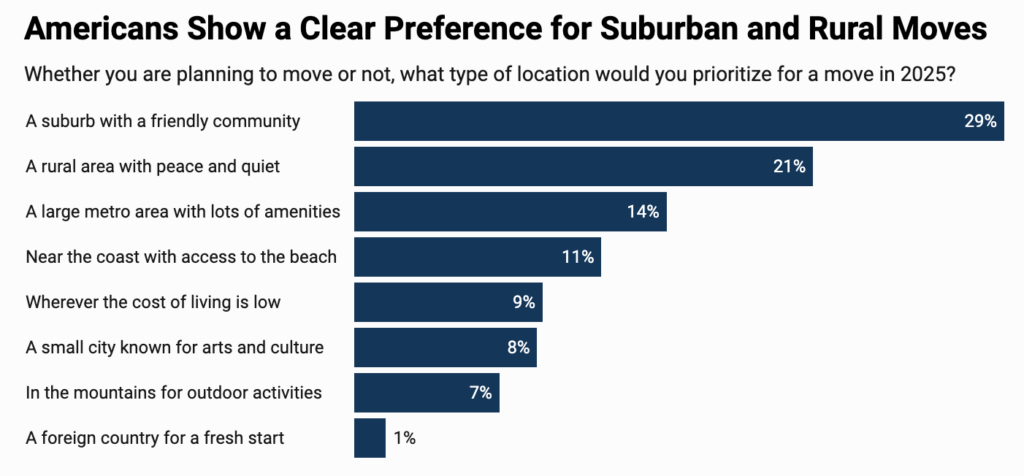2025 Forecast: Where Do Americans Want to Move? MABA MassachusettsRealEstate FirstTimeHomeBuyers MaBuyerAgent
Moving is still a major component of the American Dream, according to a recent analysis by moveBuddha. This is because people are looking for better lifestyles, more affordable housing, and financial security. But as migration rates continue to decline, fewer Americans than ever before are able to fulfill their aspirations of relocating.
Despite historically low rates of movement, a large percentage of Americans say they would like to move. Americans are asked in the study if they intend to relocate in 2025, where they would like to relocate, and why.
Why Do Americans Want to Relocate?
The “American Dream” vs. reality: While more than one-third of respondents wish to move in 2025, less than ten percent actually will. Up to thirty five percent of the 1,250 poll participants said they were planned to migrate in 2025. In line with the decades-long trend of declining migration, the actual rate of movements will most likely be closer to eight or nine percent after the year is out.
Note: This is a survey regarding moving intent and is not the same as actual relocation.
Out-of-state moves make up around one in four planned moves. Respondents who are making plans to relocate are searching farther for more “novel experiences”. About twenty eight percent of potential movers said they will move out of state, according to the research.
More than half of those potential movers some twelve percent of all respondents plan to remain inside the same municipal limits, and sixty eight percent of those who are considering a relocation in 2025 want to remain in-state.
| Response | % of all respondents | % of respondents moving |
| Yes, within the same city | 12% | 36% |
| Yes, same state, new city | 11% | 32% |
| Total in-state moves | 24% | 68% |

Additionally, an estimated four percent intend to relocate abroad. After presidential elections, there is always a spike in interest in emigration, although it usually subsides within a few weeks. On the other hand, the majority of Northeasterners are not planning to relocate, but those who are have a fifty percent higher chance of doing so than those in the West. In 2025, roughly seventy one percent of respondents who live in the Northeastern part of the United States say they have no intentions to move.
Of the four U.S. regions identified in the poll, this is the greatest retention rate; fifty seven percent of Westerners, sixty three percent of Southerners, and sixty seven percent of Midwesterners intend to remain in their current location this year. However, those who are planning to relocate are the most likely to cross state boundaries, with thirty two point eight percent intending to settle in another state, whereas residents of Northeastern states are the least likely to declare that they intend to relocate in 2025.
The majority of people contemplating a move in 2025 are from Western states. Only twenty two point five percent of potential movers in the West intend to move out of state, making them the least probable group of people with the intention of moving. Indeed, the Northeastern states are significantly smaller geographically than their Western counterparts. In the Northeast, potential movers might only need to relocate a short distance from their existing home to cross state lines.
These numbers indicate a change from recent patterns of individuals moving away from expensive coastal locations and heavily populated areas. While Westerners who are moving prefer in-state relocations, Northeasterners say they are more inclined to remain in their current location. This change raises the possibility that the enormous migration out of these areas is now slowing off.

Where’s the ‘Most Desirable’ Moving Destination?
Affordability and desirability are not always related when it comes to relocation aspirations. Large, economically prosperous states with pleasant weather and lots of opportunity tend to attract people. Regardless of whether they intended to move in 2025 or not, we asked respondents which state they would most like to move to. Florida and California were the most popular choices, followed by Hawaii in third place.
| Most desired states to move to | Least desired states to move to | ||
| Florida | 23.8% | Kansas | 0.9% |
| California | 23.3% | North Dakota | 1.1% |
| Hawaii | 15.4% | Nebraska | 1.1% |
| North Carolina | 14.6% | Mississippi | 1.2% |
| Texas | 13.9% | Iowa | 1.4% |
Florida is the most popular choice in three of the four areas, although those in the West favor California.
With the exception of the West, where California is the obvious choice, Florida is the most popular move to state in every area. Western respondents have a preference for California (forty eight percent) that is equal to the combined preferences of the second and third most popular states, Arizona (twenty three point nine percent) and Oregon (twenty three point seven percent).
The aspirational nature of the data is shown by Hawaii’s high placement on this list of the states that are most desirable to relocate. Although the idea of living on an island is quite alluring, the Aloha State actually has annual net migration rankings that are close to the bottom, coming in at number forty two in the country in 2021.
| Northeast | Midwest | South | West |
| Florida: 23.5% | Florida: 21.0% | Florida: 33.9% | California: 47.9% |
| New York: 22.5% | California: 18.6% | Georgia: 23.3% | Arizona: 23.9% |
| Pennsylvania: 21.2% | Michigan: 17.6% | North Carolina: 21.6% | Oregon: 23.7% |
| North Carolina: 18.7% | Hawaii: 15.3% | Texas: 20.0% | Hawaii: 21.3% |
| California: 15.9% | Tennessee: 14.5% | California: 17.6% | Washington: 21.2% |
Americans Still Hanging Onto Suburban Dreams
Approximately twenty nine percent of respondents said they would give priority to suburban locations in a hypothetical transfer, regardless of whether they intend to migrate in 2025. Rural places (twenty one percent) and large metro areas (fourteen percent) would follow. In this case, survey participants’ migration goals and reality coincide. Additionally, some fifty three percent of Americans aged twelve and over live in suburbs, according to the 2020 census. Further, since 2010, the likelihood of living in a suburb as opposed to a city has increased for all main racial groups.
For the ideal living situation, respondents in all four U.S. regions selected “a suburb with a friendly community” as their top choice. The suburbs outperform both options combined, despite the fact that the Northeast region of the U.S. has the highest concentration of both small and major urban centers. Northeasterners were actually the most likely demographic to express a desire to live in the suburbs, at thirty four percent. In the South, the desire for rural living is very similar to that of suburban living.
Suburban areas continue to be the most popular choice (twenty six percent), while rural peace and quiet comes in second (twenty four percent), which is the biggest percentage of any region. The only area where urban life surpasses rural preferences is the West. In this case, seventeen percent of respondents stated that they would rather live in a major city than in a rural location, compared to fourteen percent who indicated the opposite.

Survey participants were asked what factors would motivate them to relocate this year, regardless of whether they intend to move in 2025. So, what should homebuyers anticipate given that American home prices increased twice as quickly in 2024 as they did the year before?
The cost of housing in the country’s economic centers has increased so sharply that any potential income advantages from relocating there are outweighed. Because it rated ninth out of eleven reasons for migrating, the notion that people move for better employment prospects is becoming less popular. Rather, promises of self-preservation outweigh the prospect for greater income that may accompany job chances, according to sixty percent of respondents. Respondents to the survey would relocate sooner if it meant avoiding natural disasters (sixty two percent), or living in a safer neighborhood (seventy nine percent).
Meanwhile, when Americans are thinking about moving, they are more and more driven by a variety of lifestyle aspects. These include the social (being close to friends and family, sixty seven percent) and cultural (sixty four percent), as well as the environmental (having more access to nature, seventy six percent) and living space (seventy percent), as well as a warmer climate (sixty seven percent).
According to the study results, Americans in 2025 are more interested in relocating where their money will buy them a higher quality of life than they are in relocating to earn more money. And, even though more Americans are thinking about moving, fewer are actually doing it.
Americans’ desire to relocate this year dwarfs even the highest documented rates of real migration, which included a consistent pattern of over twenty percent yearly displacement during the 1950s and 1960s. This year is by no means the first year where the desire to relocate has greatly surpassed the pace of actual relocation. For example, a national survey conducted in 2020 found that over sixty five percent of respondents said they intended to move in 2021, although the year-over-year migration rate was the lowest ever.
But why?
For nearly forty years, the number of American moves has been declining due to a number of factors, including an aging population, distant employment, an increase in the number of young people living at home, the difficulties of moving two-income households, and high housing expenses. According to a 2024 National Association of Realtors research, the typical home buyer actively searches for a new residence for ten weeks before starting the buying process. This could take even longer in home areas that are especially competitive.
However, it is unlikely that many more people who might want to relocate this year would really start the relocation process. In addition to personal circumstances, ambitious movers may face challenges balancing work, family obligations, and finances during an inflationary and turbulent economic period. The American Dream is still advancing in 2025, but more slowly than in the past.
To read the full report, including more data, charts, and methodology, click here.
The post 2025 Forecast: Where Do Americans Want to Move? first appeared on The MortgagePoint.

FIRST TIME HOMEBUYERS
"Thanks to our MABA agent's knowledge, analysis, and guidance, when we found our house, we knew it was the house for us. During the negotiation, we felt confident and secure."
Article From: "Demetria C. Lester" Read full article
Get Started with MABA
For no extra cost, let a MABA buyer agent protect your interests


